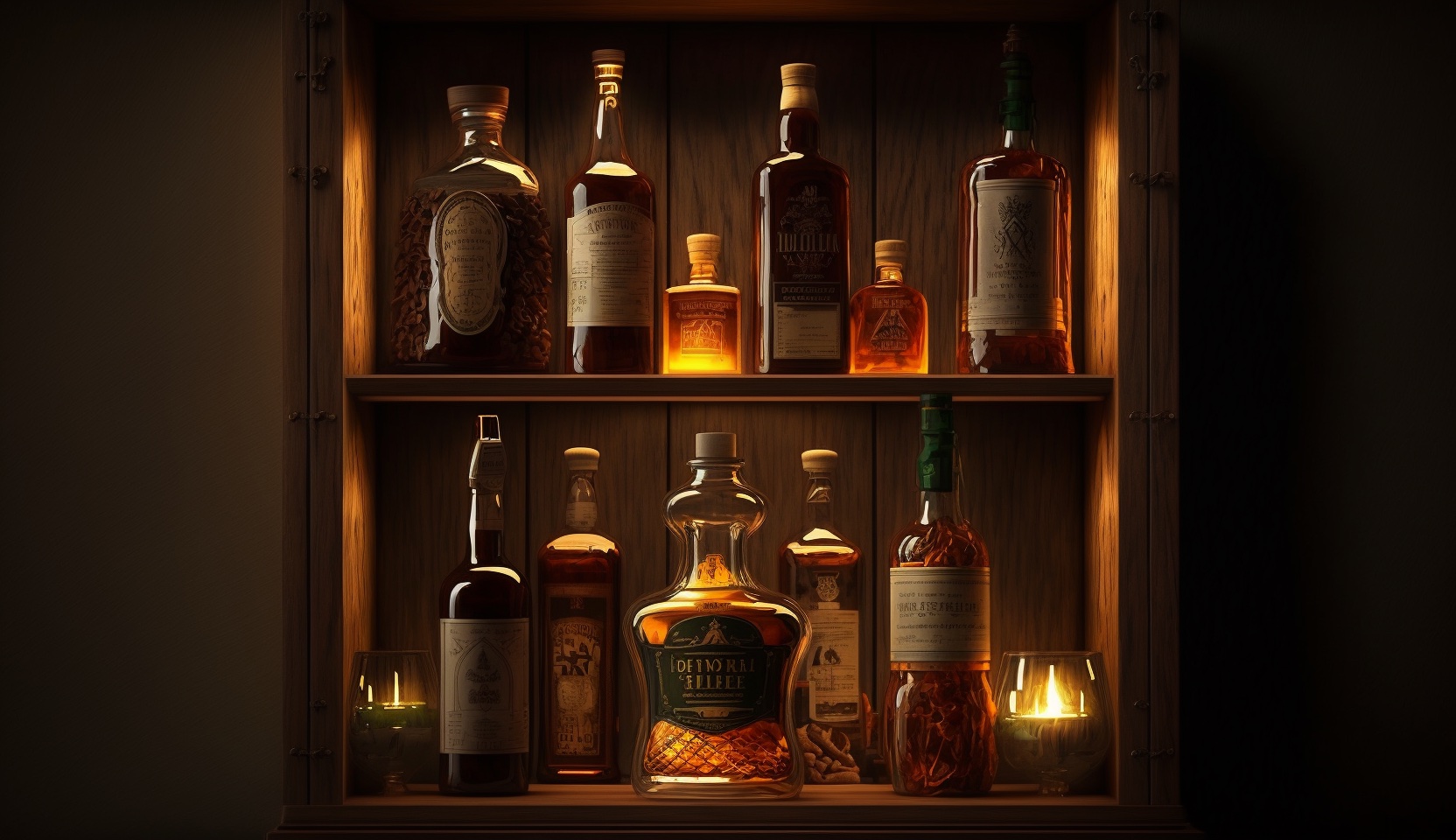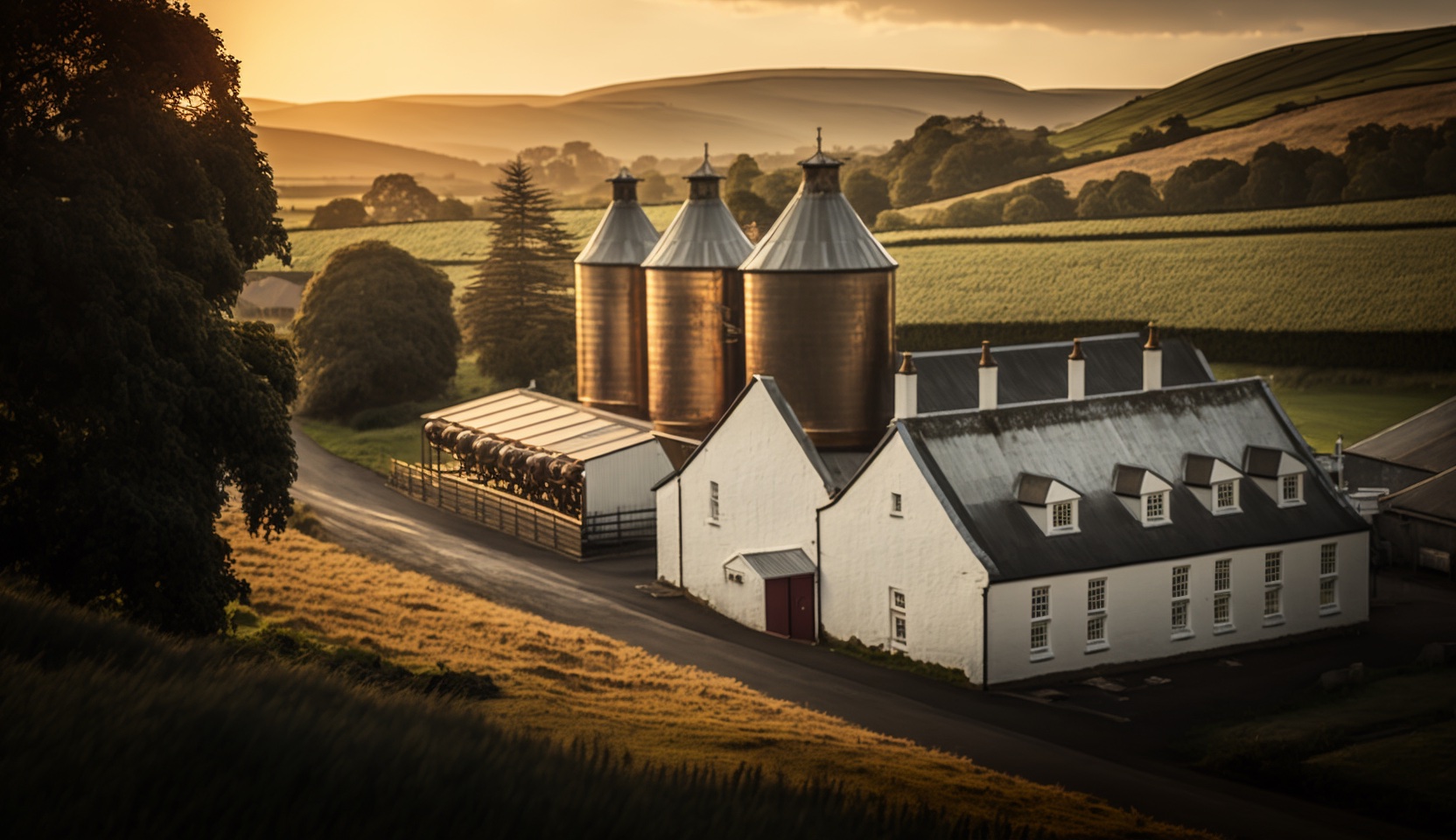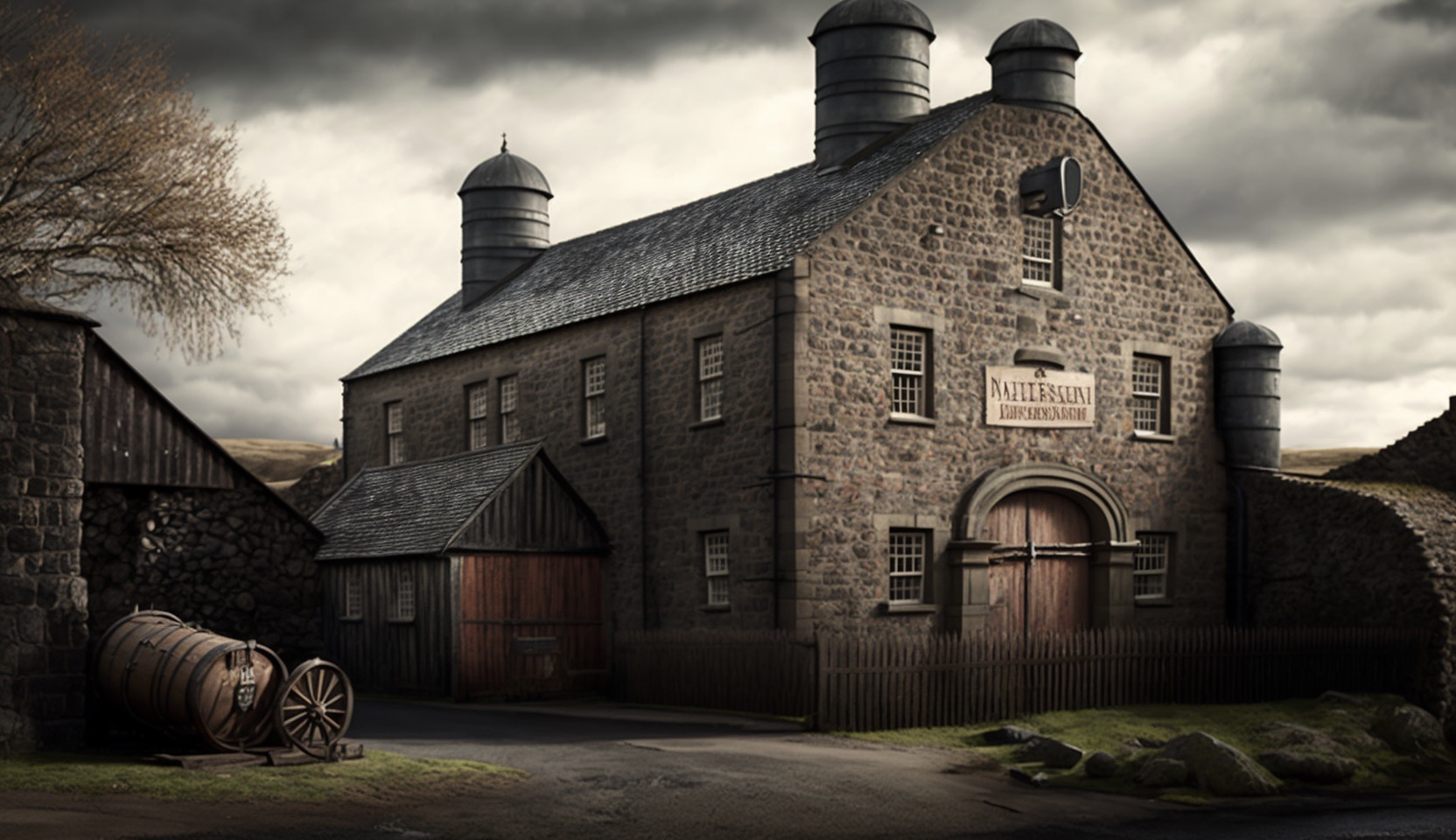How is Whisky Made?
The unmistakable aroma of whisky has been a beloved part of culture for centuries. Its wondrous flavour and robust character have made it the drink of choice for many around the world. But how exactly is this tantalising tipple created? In this article, we’ll take an in-depth look at the fascinating process behind making whisky.
Whisky production starts with malted barley or other grains being soaked in hot water to create a sugary liquid known as ‘wort‘. This wort is then fermented using yeast before being distilled through copper stills which removes any impurities and concentrates the alcohol content. Finally, the whisky is aged in oak casks, allowing its flavours to develop over time and become smoother.
Through its intricate steps, whisky provides us with a unique experience that allows us to escape from our daily lives and explore new horizons of taste. With every sip comes a journey sure to captivate your senses and free you from reality – if only just for a moment! Join us as we uncover what truly lies within each bottle of whisky.
Overview Of The Process
Whisky is a spirit made from the distillation process of fermented grain mash. Many types of whisky exist, each with its own unique character and flavour profile. The most common type is malt whisky, which can be further classified into single malt or blended whiskies.
The production of whisky starts as malted barley and other grains are mixed together in hot water to form a sweet liquid known as wort. This sugary mixture is then cooled and left to ferment for days before being distilled through copper stills. Afterward, it undergoes the maturation process where it’s stored in charred oak barrels for several years until ready to drink. By this point, all that remains is to bottle the whisky and enjoy its deliciousness!
Malted Barley And Other Grains
Whisky is traditionally made with malted barley, but other grains can also be used. Malted barley is germinated and then dried in a kiln to create malt whisky. The grain mash consists of ground up malted barley along with any other grains that are being used for the particular whisky. This mixture is then mashed and cooled until it forms a porridge-like consistency which gives the whisky its distinct flavour profile.
The resulting liquid from this process is known as wort and it’s what will eventually become whisky after fermentation and distillation have taken place. Different types of whiskies vary depending on the grains used in their production – single malt whiskies use only one type of grain whereas blended or vatted malt whiskies combine multiple different varieties together. Grain whisky on the other hand uses corn, wheat or rye instead of malted barley or as an addition to it.
The mashing and fermentation processes are integral steps in transforming these ingredients into quality whisky that people around the world enjoy today.
Mashing And Fermentation
Mashing is the process of combining hot water and cereal grain, like barley or wheat. This mixture is heated to create a liquid known as wort. The wort is then filtered and transferred into fermentation tanks where yeast is added. During this stage, sugar in the grains are converted by the yeast into ethyl alcohol and carbon dioxide gas. The fermentation process usually takes between one to three weeks depending on the type of whisky being made.
After mashing and fermentation have been completed, distillation begins. Distilling separates out different components from the fermented liquid through evaporation, leaving behind only what will become whiskey while discarding other substances that would otherwise give it an undesirable taste.
Distillation
Distillation is the process of taking the fermented liquid and separating it into its component parts. It begins with a fermented mash made from grains such as barley, rye or wheat, which is then heated in copper pot stills until the hotter vapours of alcohol rise up through the neck and are collected by condensers. The result is a distilled alcoholic beverage that contains more than 60% ABV (alcohol by volume). This liquid then goes on to be placed in oak casks for maturation and ageing – but we’ll get to that later.
The distillation of whisky allows for the removal of impurities present in the original fermented product. These include oils, fatty acids and proteins from the grain used in fermentation. Distilling also helps to increase strength without changing flavour significantly; this means less water needs to be added when bottling which can help preserve body and texture after ageing. In addition, distillation gives whisky makers control over how their spirit will taste once it has been finished – either in ex-bourbon barrels or sherry casks, for example.
Casks And Maturation
Once the whisky has been distilled, it is transferred to oak barrels for maturation. This process gives whisky its distinct flavour and colour. Wooden barrels are most often used as they allow the spirit to slowly mature while also adding unique notes of caramel and vanilla. Oak casks have an incredibly porous structure which allows air to enter over time, resulting in a mellower taste.
The length of this maturation period can vary significantly depending on the type of whisky being made. Generally speaking, lighter whiskies such as single malts are aged longer than blended whiskies or grain whiskey. Over time, some alcohol will evaporate through these wooden barrels, creating what’s known as ‘the angel’s share’.
This ageing process brings out subtleties that simply cannot be achieved any other way – ultimately giving us the richly flavoured drink we know and love today. Now that we understand how cask maturation works, let’s take a look at another important step: blending and bottling.
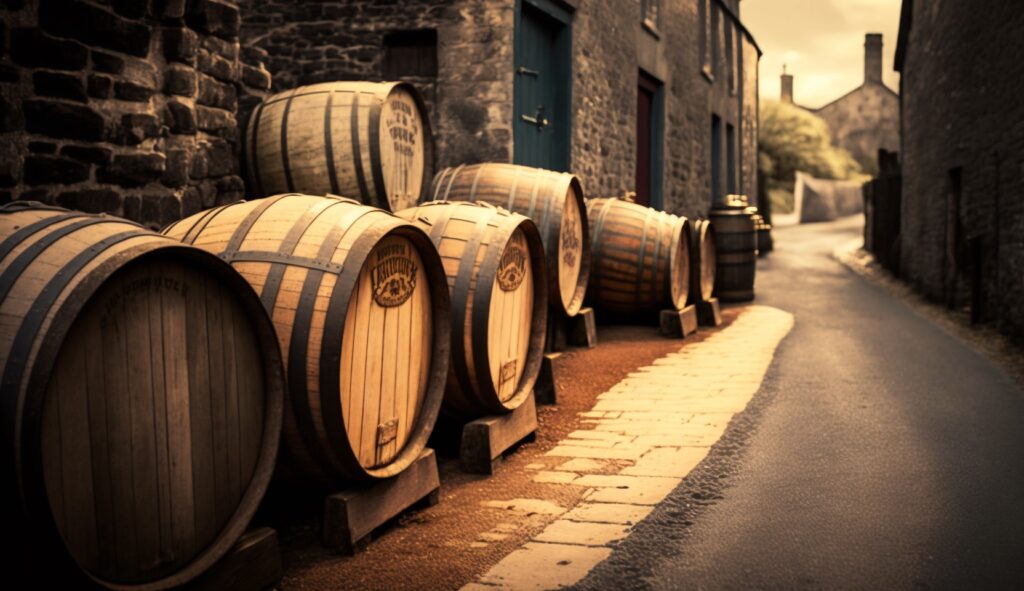
Blending And Bottling
After distillation, whisky is ready to be blended and bottled. Blended whiskey can contain both single malt scotch and grain alcohols from various sources. A blended malt is a combination of single malts that are mixed together for unique flavour profiles. Meanwhile, new charred oak barrels help the whisky develop its colour and flavour before being bottled. Depending on the bottling run, some whiskies may include additional ingredients like caramel colouring or chill-filtration techniques as part of their finishing process.
Here’s what to keep in mind when it comes to blending and bottling:
* Blended whiskies combine single malt scotch with other grain alcohols
* New charred oak barrels give the whisky its flavour & colour
* Bottling runs may involve flavouring agents & filtration processes
It’s an art form – each batch has been carefully crafted through experience and expertise to ensure consistent quality across products. With this knowledge under our belt, let’s move onto exploring different types of whisky!
Different Whisky Types
Whisky production is a complex process, and the different types of whisky produced can vary significantly. Single malt whisky is typically made from malted barley, which has been soaked in water for several days before being heated to germinate it. The grain is then dried using peat smoke and milled into grist. This grist is mixed with hot water in a mash tun and left to ferment. The fermented liquid, called wash or wort, is distilled twice in copper stills, before being aged for several years in oak barrels. During this time, whisky takes on its distinctive flavour as it matures.
Different regions produce their own unique styles of whisky through variations in the ingredients used and techniques employed during production. Scotch production has strict regulations dictating what constitutes a legally recognised product; however other countries may have more relaxed rules regarding the definition of whisky. Knowing these differences can help connoisseurs appreciate each type’s distinct character and complexity even further. From single malt whiskies to blended varieties, there’s something truly special about every bottle of whisky – no matter where it comes from. Further exploring scotch whisky production gives us a deeper understanding of how certain distilleries create such remarkable spirits.
Scotch Whisky Production
Now that we’ve discussed the different types of whisky, let’s dive into how Scotch Whiskies are made. At a whisky distillery, malted grain is ground and mixed with water in order to create what’s known as ‘mash’. The mash then ferments for several days before it goes through two rounds of distillation. The first round separates any impurities from the liquid while the second creates a clear spirit.
This liquid is then aged in wooden casks, often ex-Bourbon or Sherry wood barrels, which give the whisky its colour and flavour profile. After ageing for at least three years, this whisky must be bottled within Scotland in order to carry the label ‘Scotch’.
The process of making scotch whisky may seem relatively straightforward but there are many variables which can affect the final product; from malt selection and yeast strain used to duration of fermentation and type of cask employed.
Each step requires immense skill and attention to detail if perfection is to be achieved. These details come together to form a unique taste experience unlike anything else on earth – one that has become synonymous with Scotland itself! With all these factors taken into account, it becomes easier to understand why Scottish whiskies have such an illustrious reputation around the world. Now let’s explore how Irish Whiskey production differs from its Scottish counterpart.
Irish Whiskey Production
Irish whiskey production has a notably distinct process. It is created from three main ingredients: malted barley, unmalted grain such as rye or corn, and water. To begin the process of making Irish whisky, the grains are mashed together in hot water to extract the sugars. Then comes distillation; this happens twice for Irish whisky which helps it retain its smooth taste.
* The first distilled liquid contains more alcohol than can be legally sold as whiskey – around 70-80% ABV (alcohol by volume).
* This spirit goes through a second round of distilling that produces an even smoother drink with 50-70% ABV.
* Alcohol evaporates during maturation in oak barrels, giving whisky’s flavour and colouring over time.
This double-distilled coarse spirit is then matured for at least three years in ex-bourbon casks, although some brands also use sherry casks or Tennessee whiskey barrels to impart different flavours into their whiskies. Afterward, the mature whiskey is blended with other whiskeys before being bottled and distributed – for those producing single malt whiskey, then it will be blending with other whiskies from a single distillery. The result is what we know today as Irish Whiskey – smooth yet complex, soothingly gentle but full of character!
Japanese Whisky Production
Japanese production has been on the rise in recent years, and its unique flavour profiles have made it a favourite among connoisseurs. Cask strength whisky is produced using hot steam to extract maximum aromas from grains that make up the mash bill, then fermented and distilled at one of Japan’s many distilleries. The resulting spirit offers an unmistakable depth of flavour while maintaining a distinctively Japanese character.
In addition to traditional methods, modern innovations are helping propel Japanese whisky into new heights of popularity. Some producers age their spirits for decades before bottling them, creating complex layers of taste that can only be found in these highly sought-after bottles. With more and more drinkers developing an appreciation for the artistry behind this craftsmanship, there’s no doubt that Japanese whisky will continue to thrive well into the future.
Looking ahead to American whiskey production, we’ll explore how techniques such as barrel ageing contribute to the uniquely bold flavours associated with this iconic spirit.
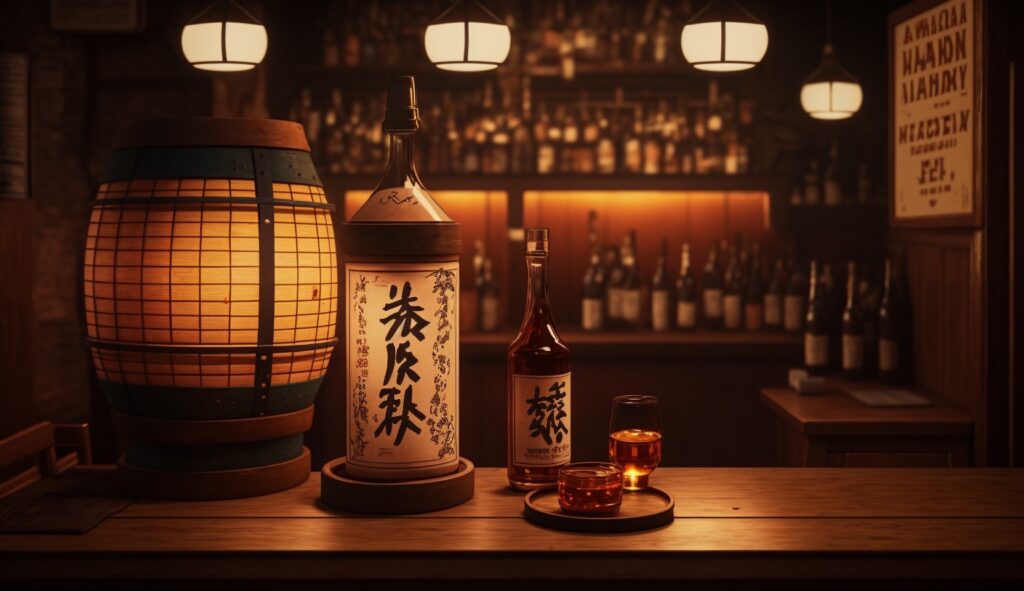
American Whiskey Production
American whiskey utilises a different technique to that of the Japanese distilleries. Corn whiskey is distilled from a mash made predominantly with corn and other grains like barley or rye are added to give it flavour. The fermentation stage also differs in that it uses cold water instead of hot. This results in a more mellow taste.
Once the distillation process has been completed, the liquid undergoes ageing before being bottled as single barrel products or blended together for mass production. While not all American whiskies use oak barrels for ageing, most do due to its ability to help draw out flavours while simultaneously preventing oxidation which could affect the quality of the spirit. Furthermore, some producers may add additional ingredients such as honey to further enhance their character.
The result is an array of unique whiskeys that differ greatly depending on where they’re produced and how they were crafted by master distillers. Each region can offer something special – from light-bodied bourbons from Tennessee to spicy rye whiskey from Pennsylvania – thus giving consumers worldwide something new to try each time they pick up a bottle of America’s favourite spirit.
Conclusion
In conclusion, production is an intricate process that varies from country to country, whether it is American, Scotch or Canadian whisky. To make a high-quality product, it’s important for distillers to use the best ingredients and techniques available.
To produce Scotch whisky, malted barley and other grains are used in combination with mashing and fermentation processes before being distilled twice or more. The liquid is then aged in casks for two years or longer. Irish whiskey employs similar tactics but differs from Scotch with its triple distillation process. Japanese whisky follows Scottish traditions while American produces various types of whiskeys under different regulations.
No matter which type of spirit you prefer, there’s no doubt that whisky requires dedication and skill by those involved in the industry, who strive to bring us the highest quality beverage possible.
Frequently Asked Questions
The three main ingredients in whisky are grain mash, yeast, and water. Grain mash is usually made from malted grain, such as barley, but can also include other grains like rye or corn.
The length of time it takes to age whiskey depends on the type of whiskey and the distillery producing it. Generally, most whiskies are aged for at least three years, but some can be aged for decades.
Ethyl alcohol is used in whisky. This is the type of alcohol that is produced through the fermentation process of the grain mash.
Whiskey that has not been aged is called “white dog” or “new make” whiskey. It is colourless and has a high alcohol content, often over 60% ABV.
No, you cannot make whiskey from vodka. Whiskey is made from fermented grain mash, while vodka is made from any fermented food or agricultural product that can be distilled. The resulting liquid is then filtered and purified, resulting in a neutral-tasting spirit.
